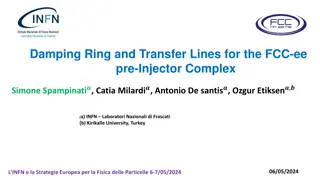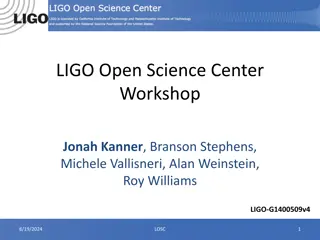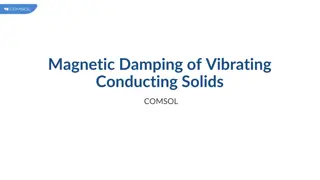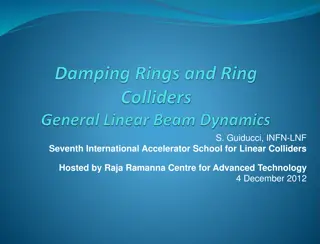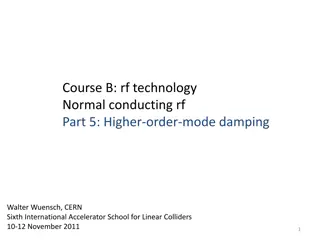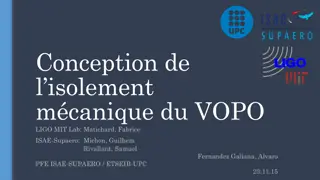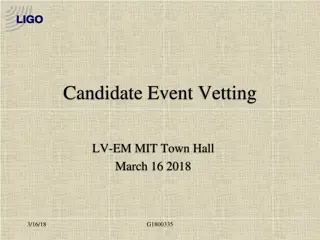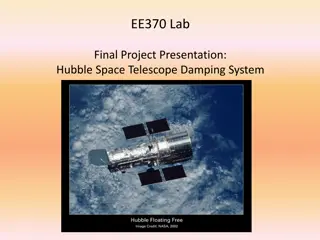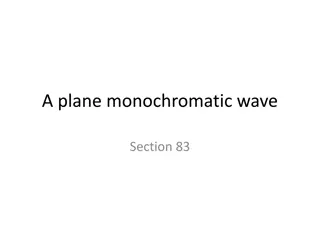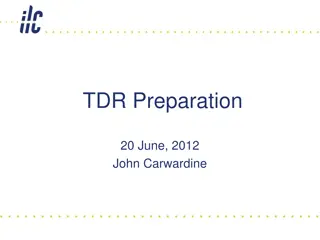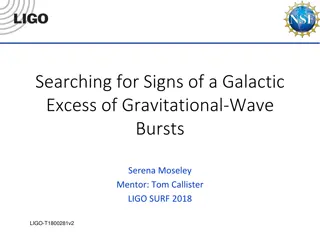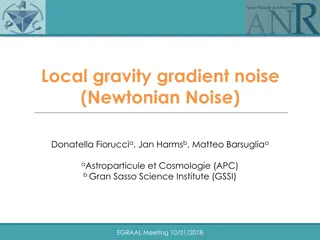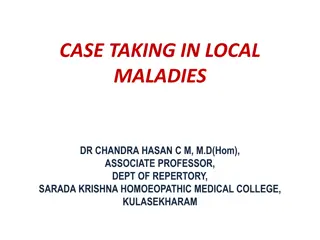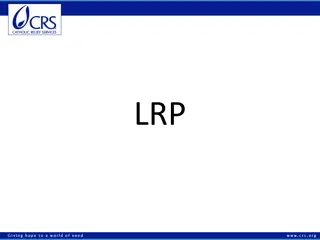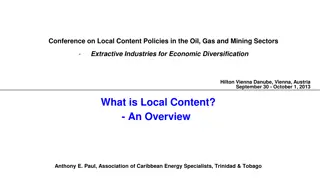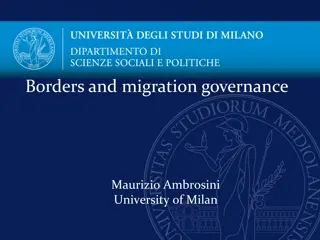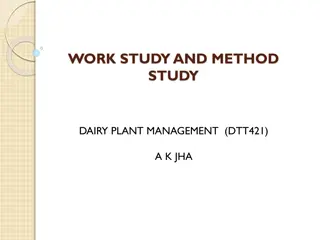LIGO Global vs. Local Damping Study
LIGO conducted a study comparing global and local damping effects in their system. The research delved into common arm length damping, differential arm length dynamics, and simulated common length damping scenarios. Various configurations and sensor noise considerations were explored to understand the impact on cavity control and mass response in different scenarios.
Download Presentation

Please find below an Image/Link to download the presentation.
The content on the website is provided AS IS for your information and personal use only. It may not be sold, licensed, or shared on other websites without obtaining consent from the author. Download presentation by click this link. If you encounter any issues during the download, it is possible that the publisher has removed the file from their server.
E N D
Presentation Transcript
LIGO Global longitudinal quad damping vs. local damping Brett Shapiro Stanford University G1200774-v15 1/36
LIGO Summary Background: local vs. global damping Part I: global common length damping Simulations Measurements at 40 m lab Part II: global differential arm length damping without OSEMs Simulations Measurements at LIGO Hanford Conclusions G1200774-v15 2/36
Usual Local Damping ETMX ETMY xx,1 xy,1 -1 -1 ux,1 uy,1 ux,2 uy,2 Local dampin g Local dampin g ux,3 uy,3 The nominal way of damping OSEM sensor noise coupling to the cavity is non-negligible for these loops. The cavity control influences the top mass response. Damping suppresses all Qs xx,4-xy,4 ux,4 uy,4 Cavity control 0.5 0.5 3/36
Common Arm Length Damping ETMX ETMY -1 ( ) -0.5 xx,1+xy,1 2 + -0.5 ux,1 uy,1 ux,2 uy,2 Common length damping Common length DOF independent from cavity control ux,3 uy,3 The global common length damping injects the same sensor noise into both pendulums xx,4-xy,4 ux,4 uy,4 Both pendulums are the same, so noise stays in common mode, i.e. no damping noise to cavity! Cavity control 0.5 0.5 4/36
Differential Arm Length Trans. Func. Top Mass Force to Displacement Transfer Function * * 0 10 ETMX ETMY longitudinal Magnitude (m/N) -1 ( ) -0.5 -2 10 xx,1-xy,1 2 - -0.5 -4 10 ux,1 uy,1 ux,2 uy,2 -6 10 -1 0 1 10 10 10 * Differential top to differential top transfer function Frequency (Hz) ux,3 uy,3 The differential top mass longitudinal DOF behaves just like a cavity-controlled quad. Assumes identical quads (ours are pretty darn close). See `Supporting Math slides. ux,4 uy,4 Cavity control 0.5 0.5 5/36
Simulated Common Length Damping ETMX ETMY -1 ( ) -0.5 xx,1+xy,1 2 Realistic quads - errors on the simulated as-built parameters are: + -0.5 ux,1 uy,1 ux,2 uy,2 Masses: 20 grams Common length damping d s (dn, d1, d3, d4): 1 mm Rotational inertia: 3% ux,3 uy,3 Wire lengths: 0.25 mm xx,4-xy,4 Vertical stiffness: 3% ux,4 uy,4 Cavity control 0.5 0.5 6/36
Simulated Damping Noise to Cavity Red curve achieved by scaling top mass actuators so that TFs to cavity are identical at 10 Hz. 8/36
40 m Lab Noise Measurements Seismic noise OSEM sensor noise Laser frequency noise 10/36
40 m Lab Noise Measurements Ratio of local/global Local ITMY damping Global common damping OSEM noise + Damp control Plant cavity signal Ideally zero. Magnitude depends on quality of actuator matching. Cavity control 11/36
Differential Arm Length Damping ETMX ETMY 1 2 ( ) xx,1-xy,1 Top Mass Force to Displacement Transfer Function * * 0 10 - 0.5 0.5 longitudinal ? Magnitude (m/N) -2 10 ux,2 uy,2 * Differential top to differential top transfer function -4 10 -6 10 ux,3 uy,3 -1 0 1 10 10 10 Frequency (Hz) If we understand how the cavity control produces this mode, can we design a controller that also damps it? ux,4 uy,4 If so, then we can turn off local damping altogether. Control Law 0.5 0.5 13/36
Differential Arm Length Damping Pendulum 1 f2 x4 The new top mass modes come from the zeros of the TF between the highest stage with large cavity UGF and the test mass. See more detailed discussion in the Supporting Math section. This result can be generalized to the zeros in the cavity loop gain transfer functions (based on observations, no hard math yet). 14/36
Differential Arm Length Damping Test UGF: 300 Hz PUM UGF: 50 Hz UIM UGF: 10 Hz 19/36
Differential Arm Length Damping Test UGF: 300 Hz PUM UGF: 50 Hz UIM UGF: 5 Hz 20/36
Differential Arm Length Damping The top mass longitudinal differential mode resulting from the cavity loop gains on the previous slides. Damping is OFF! 21/36
Differential Arm Length Damping Top mass damping from cavity control. No OSEMs! 22/36
LHO Damping Measurements Setup MC2 triple suspension Test procedure Vary g2 and observe the changes in the responses of x1 and the cavity signal to f1. Variable gain f1 x1 M1 Terminology Key IMC: input mode cleaner, the cavity that makes the laser beam nice and round M1: top mass M2: middle mass M3: bottom mass MC2: Mode cleaner triple suspension #2 C2: M2 feedback filter C3: M3 feedback filter f2 g2 C2 M2 f3 IMC Cavity signal M3 C3 -1 23/36
LHO Damping Measurements Terminology Key M1: top mass M2: middle mass M3: bottom mass MC2: triple suspension UGF: unity gain frequency or bandwidth 24/36
LHO Damping Measurements Terminology Key IMC: cavity signal, bottom mass sensor M1: top mass M2: middle mass M3: bottom mass MC2: triple suspension UGF: unity gain frequency or bandwidth 25/36
LIGO Conclusions Very simple implementation. A matrix transformation and a little bit of actuator tuning. Overall, global damping isolates OSEM sensor noise in two ways: 1: common length damping -> damp global DOFs that couple weakly to the cavity 2: differential length damping -> cavity control damps its own DOF Can isolate nearly all longitudinal damping noise. If all 4 quads are damped globally, the cavity control becomes independent of the damping design. 34/36
LIGO Conclusions cont. Broadband noise reduction, both in band (>10 Hz) and out of band (<10 Hz). Applies to other cavities, e.g. IMC. Limitations: Only works for longitudinal, maybe pitch and yaw Adds an extra constraint to the cavity control, encouraging more drive on the lower stages 35/36
LIGO Acknowledgements Caltech: 40 m crew, Rana Adhikari, Jenne Driggers, Jamie Rollins LHO: commissioning crew MIT: Kamal Youcef-Toumi, Jeff Kissel. 36/36
LIGO Backups 37
Supporting Math 1. Dynamics of common and differential modes a. Rotating the pendulum state space equations from local to global coordinates b. Noise coupling from common damping to DARM c. Double pendulum example Change in top mass modes from cavity control simple two mass system example. 2. 39
DYNAMICS OF COMMON AND DIFFERENTIAL MODES 40
Rotating all ETMX and ETMY local long. DOFs into global diff. and comm. DOFs Local ETMX Longitudinal Plant x =Axx+Bxux xm=Rx+nx ym= Ry+ny Local to global transformations: Local ETMY Longitudinal Plant y=Ayy+Byuy R = sensing matrix n = sensor noise d=(x-y) Differential displacement signals c=(x+y)/2 Common displacement signals ud=ux-uy Differential control signals uc=(ux+uy)/2 Common control signals = = = = A A A B B B Ideal case : , Combined Differenti al/Common system matrix x y x y = + d Ad Bu global differenti plant al d u A 0 d B 0 d d = + = + c Ac Bu global common plant u 0 A c 0 B c c c
Rotating all ETMX and ETMY local long. DOFs into global diff. and comm. DOFs Determining the coupling of common mode damping to DARM Gdamp= damping control Rs,damp= damping sensor matrix Ra,damp= damping actuation matrix nx= ETMX top mass long. sensor noise ny= ETMY top mass long. sensor noise Now, substitute in the feedback and transform to Laplace space: Grouping like terms: 42
Rotating all ETMX and ETMY local long. DOFs into global diff. and comm. DOFs Solving c in terms of d and : Plugging c in to d equation: Defining intermediate variables to keep things tidy: n Then d can be written as a function of : Dd =-Nn d =-D-1Nn 43
Rotating all ETMX and ETMY local long. DOFs into global diff. and comm. DOFs Then the transfer function from common mode sensor noise to DARM is: d4=Rs,cavityd, DARM cavity error d4 n =-Rs,cavityD-1N, TF between commom mode top mass sensor noise and DARM error As the plant differences go to zero, N goes to zero, and thus the coupling of common mode damping noise to DARM goes to zero. 44
Simple Common to Diff. Coupling Ex. To show what the matrices on the previous slides look like. ETMX ETMY Common damping ux1 uy1 ky1 c1 kx1 + mx1 my1 0.5 0.5 x1 x2 ky2 kx2 mx2 my2 d2 DARM Error Gdamp= damping control filter Rs,damp= damping sensor matrix Ra,damp= damping actuation matrix Rs,cavity= cavity sensor matrix d = differential DOFs c= common DOFs nx= ETMX top mass long. sensor noise ny= ETMY top mass long. sensor noise c1 c2 c1 c2 c1=Rs,dampc= 1 0 0 0 1 0 Ra,damp= d1 d2 d1 d2 d2=Rs,cavityd = 0 1 0 0 45
ETMY A Matrix ETMX A Matrix 0 0 0 0 1 0 0 1 0 0 0 0 1 0 0 1 - ky1+ky2 ( my1 ) - kx1+kx2 ( mx1 ) 0 0 ky2 0 0 kx2 Ay= Ax= -kx2 mx2 -ky2 my2 0 0 kx2 0 0 ky2 Common A Matrix 0 0 0 0 1 0 0 1 ( )mx1 - kx1+kx2 ( )my1- ky1+ky2 mx1my1 A = Ax+Ay ( )/2 = kx2+ky2 0 0 /2 -kx2my2-ky2mx2 mx2my2 kx2+ky2 0 0 Differential A Matrix 0 0 0 0 1 0 0 1 ( )mx1 - kx1+kx2 ( )my1+ ky1+ky2 mx1my1 A = Ax-Ay ( )/2 = kx2-ky2 0 0 /2 -kx2my2+ky2mx2 mx2my2 kx2-ky2 0 0 46
Simple Common to Diff. Coupling Ex ETMX B Matrix Common B Matrix 0 0 1 0 0 0 0 0 0 mx1+my1 mx1my1 0 B= Bx+By ( )/2 = 0 Bx= /2 mx1 1 mx2+my2 mx2my2 0 0 mx2 Differential B Matrix ETMY B Matrix 0 0 0 0 0 0 1 0 0 mx1-my1 mx1my1 B= Bx-By ( )/2 = 0 0 /2 By= my1 mx2-my2 mx2my2 1 0 0 my2 47
Simple Common to Diff. Coupling Ex d4=Rs,cavityd, DARM cavity error d4 n Plugging in sus parameters for N: =-Rs,cavityD-1N, TF between commom mode top mass sensor noise and DARM error 0 0 0 0 1 0 0 1 0 0 0 0 ( )mx1 - kx1+kx2 ( )my1+ ky1+ky2 mx1my1 mx1-my1 mx1my1 Gdamp 1 2 -1 1 0 0 kx2-ky2 0 0 1 0 0 0 ... 2 mx2-my2 mx2my2 -kx2my2+ky2mx2 mx2my2 0 kx2-ky2 0 0 Gdamp 1 0 N= 2 -1 0 0 0 0 1 0 0 1 0 0 0 0 0 0 0 0 0 0 0 0 ( )mx1 - kx1+kx2 ( )my1- ky1+ky2 mx1my1 mx1+my1 mx1my1 mx1+my1 mx1my1 mx1-my1 mx1my1 Gdamp ... sI-1 +1 1 2 +1 1 0 0 0 0 kx2+ky2 0 0 1 0 0 0 2 2 2 mx2+my2 mx2my2 mx2+my2 mx2my2 mx2-my2 mx2my2 -kx2my2-ky2mx2 mx2my2 0 0 0 kx2+ky2 0 0 48
CHANGE IN TOP MASS MODES FROM CAVITY CONTROL SIMPLE TWO MASS SYSTEM EXAMPLE. 49
Change in top mass modes from cavity control simple two mass ex. Question: What happens to x1 response when we control x2 with f2? x2 x1 f1 Stiffness Matrix Mass Matrix k1 k2 k1+k2 -k2 -k2 k2 f2 0 m1 0 K = M= m1 m2 m2 Equation of Motion + -k2 = k1+k2 -k2 k2 0 m1 0 x1 x2 x1 x2 f1 f2 m2 When f2 = 0, The f1 to x1 TF has two modes 50


